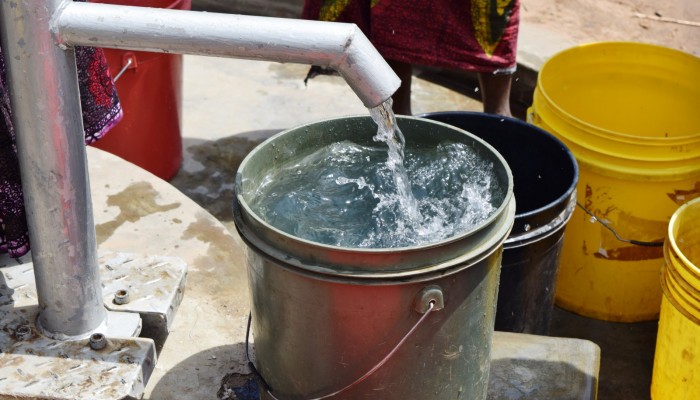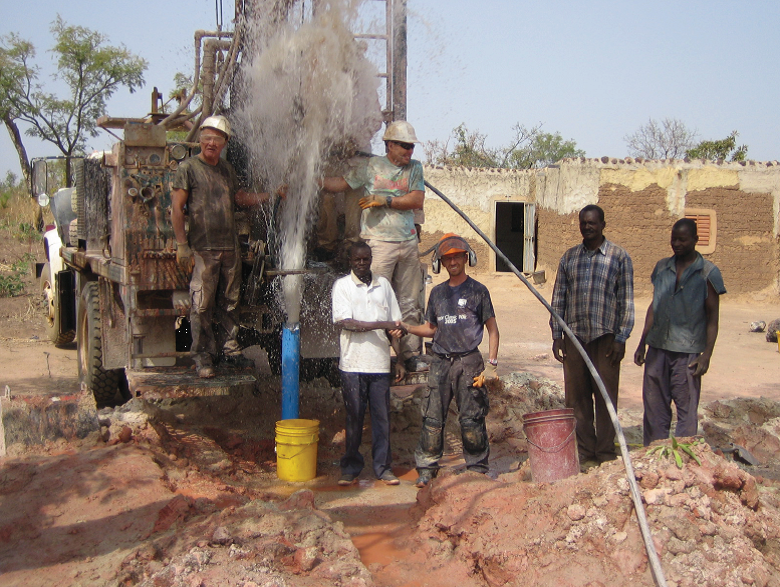
Yesterday we shared a blog written by Christopher Barry (University of Birmingham), outlining previous work in Burkina Faso with the charity ‘Friends in Action’. Christopher and Logan Mills (University of Warwick) are cycling 270 km from Bristol to Birmingham on the 12th and 13th December, in aid of ‘Friends in Action’, and here write about their latest contribution to this important work to provide clean water.
Friends in Action
We are excited to be supporting Friends in Action, who expertly combine good engineering with compassionate work alongside the communities they seek to serve. Their technical expertise can be observed in the drilling success rate of 75% producing water, compared to a national average in Burkina Faso of 55%. Their careful consideration and involvement of the communities is also vital. Of the approximately 200 wells they have constructed, only one has fallen into disrepair, so they have been well maintained by the villages.
Friends in Action typically work with a drilling rig and teams of volunteers during the drilling season (October to April). The team camps in the villages where they are working and shares meals with the residents. A Burkinabé pastor accompanies each team who acts as translator and, importantly, shares the motivation of Christian compassion behind the work. It is important not only to communicate well with the eventual users of the well, to ensure that their needs are considered, but also to affirm that the new well is intended for their benefit, not as an imposition.
Christopher, a hydrogeology PhD student at the University of Birmingham, is planning to join one of these teams of volunteers in March, awaiting confirmation that the trip is feasible given the current political unrest in Burkina Faso.
The cycle route
We (Logan and Christopher) plan to cycle from Bristol to Birmingham over two days (12-13th December). To make the connection to water resources, we are going to cycle a route that traverses five of Britain’s six major aquifer rock units (according to Allen et al., 1997). Around one third of our water in Britain derives from groundwater resources and we are privileged that as consumers we seldom have to give thought to the source of our tap water.
The route will start from the station in Bristol, heading south to the aptly-named town Wells in the Mendip Hills, made of Carboniferous Limestone. From there we will head east, through the Lower Greensand and then into Chalk at Marlborough. From there we head north through Swindon and the Cotswolds, crossing Jurassic Oolithic Limestone sequences. We arrive in Stratford-upon-Avon following the canal north to the University of Birmingham, which lies on Permo-Triassic Sandstone. All going well, the journey will take an evening and two full days, covering about 270 km. For those of you who are interested, we have more on the aquifer units below.
Please sponsor us!
We would be greatly encouraged by your support for us and ultimately, Friends in Action. Of the donations that we receive:
- Half will go direct to the work of Friends in Action (FiA).
- Half will support Christopher towards joining a volunteer team in March (agreed with FiA); if the trip has to be cancelled, then the money will go to support the work of FiA.
Please note that the cycle trip expenses will be kept to a minimum and covered out of our own pockets.
Please visit https://www.justgiving.com/ChristopherJBarry/ to support and www.fiaintl.org to find out more about the charity.
The Groundwater Resources of Britain
The Carboniferous Limestone forms some of the most striking landscapes in the UK, including the Peak District and the Mendips. Water flows in conduits and caves which have been formed by dissolution in a complex network. Mineral Waters such as Buxton™ are derived from these aquifers.
The Permo-Triassic Sandstone is the second most important aquifer type in the UK, giving part of the water supply to Manchester, Nottingham and the West Midlands. These sandstones were formed in the basins between mountains uplifted in the Variscan Mountain-Building event. Water flows in both the pore spaces between grains and faults.
The Jurassic Limestone stretches from Dorset to Yorkshire. These rocks were formed in shallow shelf tropical sea environments – the type that make good holiday destinations today. Flow is mostly through solution enlarged fractures, as with the Carboniferous Limestone.
The Lower Greensand is found discontinuously at the base of the chalk, particularly north of London, Bedfordshire, the Weald and the Isle of Wight. The lithology is highly variable and often neither green nor sandy. We will cross a small section in the South-West, although its importance to groundwater resources is mostly north of London.
The Chalk is the most important aquifer unit in the UK, accounting for more than half of all groundwater use in the country. Flow is through fractures, as with other limestones. The chalk is seen famously in the White Cliffs of Dover, and outcrops in the South, South-East and East Anglia and is found under London overlain by a thick layer of clay. Representing a major submersion event in the Cretaceous, the chalk is formed almost entirely of shell fragments of tiny micro-organisms called coccolithophores.
Apologies to the Permian Magnesian Limestone/ Dolostone, between Nottingham and Sunderland, which we have had to omit on our cycle. This aquifer is an important water source in Northumbria and Yorkshire. Geologically it represents cyclically rising and falling sea-levels during the Permian Period.
Christopher Barry is a PhD student at the University of Birmingham studying contaminant hydrogeology. Logan Mills is studying for a postgraduate medicine degree at the University of Warwick, following an undergraduate degree at the University of Cambridge in geology
Reference
Information about aquifers summarised from:
Allen, D. J., Brewerton, L. J., Coleby, L. M., Gibbs, B. R., Lewis, M. A., MacDonald, A. M., Wagstaff, S. J., Williams, A. T. (1997) The physical properties of major aquifers in England and Wales. British Geological Survey Technical Report WD/97/34. 312pp. Environment Agency R&D Publication 8.


